Existing User Log In
New User Registration
Register for a free account to gain full access to the VGChartz Network and join our thriving community.



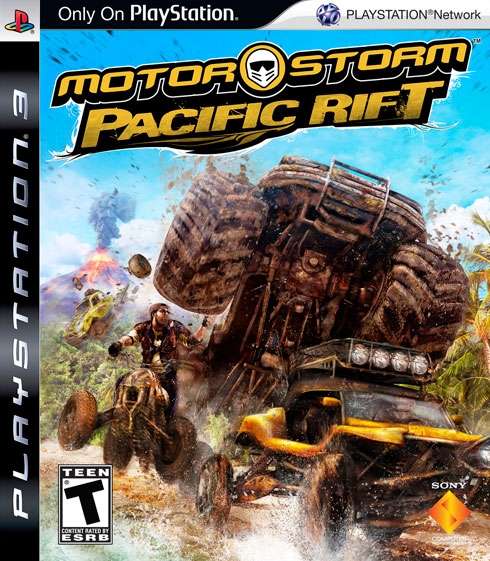

America - Front
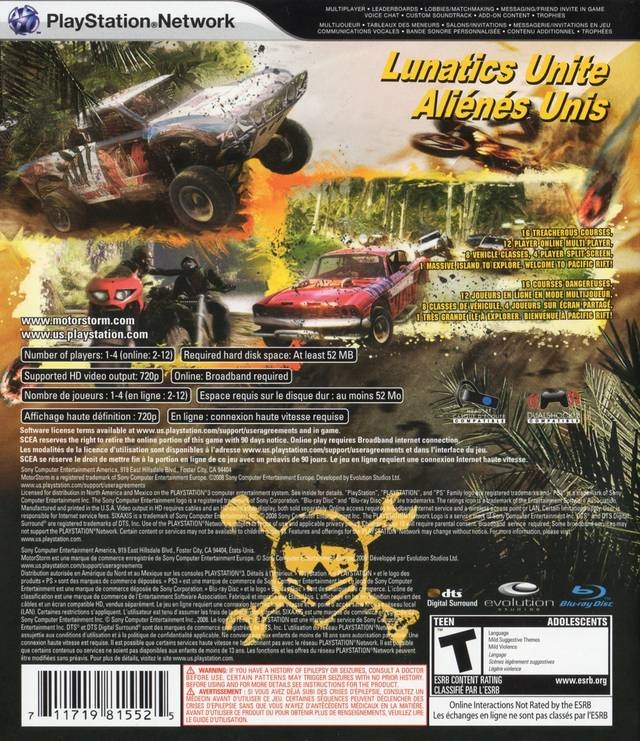

America - Back

I purchased MotorStorm: Pacific Rift with some degree of trepidation. Despite enjoying the original MotorStorm a lot, the demo that was initially released on the PSN for Pacific Rift back in October 2008 was extremely disappointing. It was a major step backwards in almost every respect; from the track design to the graphics to the handling of the vehicles, almost everything was worse in comparison to the original MotorStorm. The only noticeable improvements were the inclusion of split screen multiplayer and much shorter loading times, hardly worthy inclusions if they came at the expense of all that made the original so good. You’ve no doubt already seen the score I’ve given Pacific Rift, so what gives? The good news is that the demo, whilst almost certainly successful in achieving the rather dubious aim of holding back sales of Pacific Rift, is actually not representative of the final build. And what a relief it is to be able to say that. MotorStorm is back and it feels just like the original. Much bigger, and in many respects better, Pacific Rift is a truly worthy sequel.
As with the original, the main single player focus is put on a Festival mode where you compete in races in order to unlock more tracks, vehicles, vehicle skins and events. In Pacific Rift, this rewards system has been expanded to include even more extras, like unlockable concept art, video clips and new race characters. It also unlocks more content in the Free Race mode, as well as Speed and Eliminator races for the Festival (more on all that later). As with so much in Pacific Rift, the developers have taken an idea introduced in the original and expanded it to make it much more important and to give the user more options and more content to play around with.
Pacific Rift introduces a leveling system similar to that found in Forza 2 on the Xbox 360. In Pacific Rift you compete in races to gain experience points. You’re given points based on how well you do in each race (50 points for bronze, 75 for silver and 100 for gold), and they’re then added to your total experience. Once you reach the next level you unlock more goodies, all while you continuing to build experience towards the next level. Each new level becomes harder to obtain, and the races assigned become more and more challenging. It’s a nice system; it’s not ground-breaking, but it gives you more flexibility than the original game did.
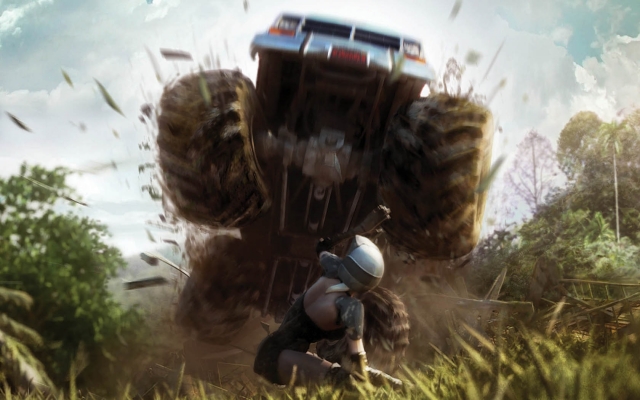
The gameplay hasn’t changed much and the vehicles control and feel the same as they did in the original, so fans of the first MotorStorm should be happy. All of the original vehicle types and skins make a return, as well as a few new ones, and their strengths and weakness have all been carried over. There have been a few minor changes though – you can now bunny hop and crouch on bikes and ATVs, the number of taunts has been increased, and the motion controls can now be used to tilt your vehicle if you’re about to topple over.
The most noticeable change is obviously the inclusion of the monster truck in the line-up. The bad news is this means that the slower vehicles are now equal in number to the faster vehicles in the vehicle selection screen, which in turn means that there are now more ‘slow’ races in the Festival mode than there were in MotorStorm. The good news is that the monster truck is perhaps what the big rig should have been in the original – able to physically dominate other vehicles without slowing down too much. The huge tires and hefty suspension mean you can crush a buggy or rally car and barely notice it. It also opens up more track possibilities. For example, one track has a river flowing through the middle of it that offers up a more direct route to the finish line, but it’s virtually inaccessible to the other vehicles due to the huge rocks and boulders that are scattered on the riverbed. For the monster truck they aren’t a major problem, and can be scaled without wrecking. On the whole I’m not blown away by the inclusion of the monster truck although I find it preferable to the other slower vehicles like the big rig and mudplugger. It also adds more variety to the game, so in that sense it is a positive addition to the series.
One change which has gone relatively unreported, but which has actually had a major impact on the gameplay, is the added importance of the power boost. It’s no longer sufficient to just use the boost, you now have to make full use of the environment to maximise the potential of it, or otherwise the second half of the Festival mode will prove impossible to complete. This means making full use of the track surfaces that benefit your vehicle type whilst at the same time avoiding those that hinder your vehicle as much as possible. It also means avoiding the area of effect of the lava pools, which overheat your engine, and using the water shower tunnels, puddles and rivers which cool it down. These changes may sound small but they have had a significant impact on the game and have made the Festival mode much harder.
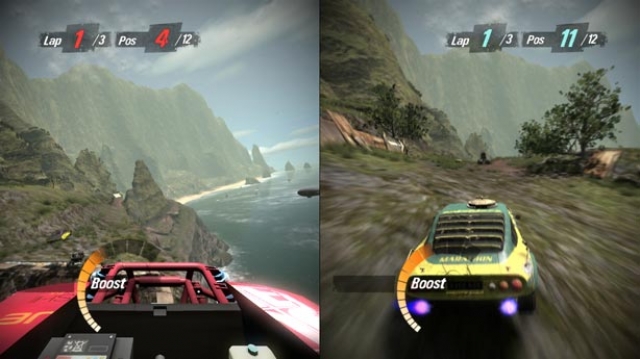
However, the one change that is now sorely needed, but which has not been implemented in Pacific Rift, is the toning down of AI rubber-banding. The AI is unchanged from MotorStorm. This means that frustrating instances of AI vehicles slowing down just to block your path make a reappearance, as do the instances of the AI drivers ‘cheating’ by being able to completely destroy any lead you’ve built up within seconds by using their seemingly unlimited boost. Aggressive and intelligent AI driving is always welcomed, but this extreme form of rubber-banding which remains unchanged is not, particularly as the difficulty level is bumped up in Pacific Rift from the get-go thanks to the increased importance of the boost and learning the optimum route for each vehicle.
The island’s Festival is split into four zones – earth, air, fire and water. Maps in the earth zone usually focus on mud and dense jungle settings, water maps usually interact with beach coastline and rivers, air maps are usually set high up in the mountains with the clouds and allow for high jumps and long downhill stretches, and finally the fire maps are ash-covered tracks set amongst vast lava pools. It means there’s a lot more variety in map setting than there was in the original MotorStorm, and so once you get bored of a particular zone you can just move on to another one where the racing experience will be different.
As with the original, each track has multiple routes, all of which favour some vehicle types over the others. Where Pacific Rift differs slightly is in the scale of map. Here, almost all of the maps are truly huge and offer up so many different routes that it will take you the entire Festival mode and then some before you’ve genuinely learnt them all. It can be quite overwhelming at first, much more so than in the original MotorStorm, as so many of the routes are hidden and it really does take a long time to learn the best route for each vehicle (which is where the Time Attack mode becomes really useful as it allows you to download ghosts which you can learn the routes from).
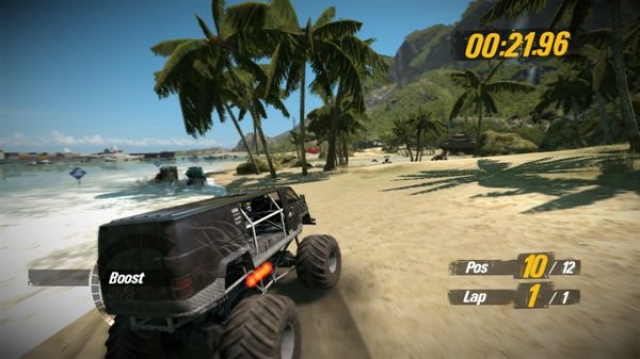
The car models haven’t changed much since the original, but the vehicle crashes have been nicely updated. There’s now more detail to the crashes, and vehicles interact much more realistically with the environment, for example if you crash into a tree your car will wrap around it in slow-motion. Tracks are now more varied thanks to the inclusion of the four separate zones. I personally preferred MotorStorm’s desert setting over Pacific Rift’s island setting, but there’s no denying that these tracks are much more detailed and are full of environmental objects and features, from trees and plants to flowing rivers, waterfalls and beachfront vistas. If you had serious concerns about the graphics in the demo then rest assured that the final build is a vast improvement over that. The demo looked like a step backwards for the franchise, but the final build is certainly a step forwards. On the technical front the game is much the same as the original, but with one significant improvement. Loading times have been drastically reduced and switching between different vehicle types and skins is a much quicker process.
If there’s one negative to the graphics then it’s definitely the textures, which are noticeably low-res at times. You’ll likely only notice this during the initial three second introduction cut-scene period on the starting grid, where all of the vehicles look totally out of place against the ground, or if you break away from the race and go and stare at a mountain wall, but it does nevertheless detract from the otherwise excellent presentation.
Sound effects follow on from the first MotorStorm where engines roared and the crashes were crisp and impactful. The ‘beeping’ turbo boost also makes a welcome return. The soundtrack consists of licensed rock, metal, and electronic music from a number of artists, including David Bowie, Nirvana, Ministry, Megadeath, Machine Head, Aphex Twin, Slipknot, and so on. In total there are 46 music tracks, compared to the 20 or so included with the original MotorStorm, and you can remove tracks that you don’t like from the playlist.
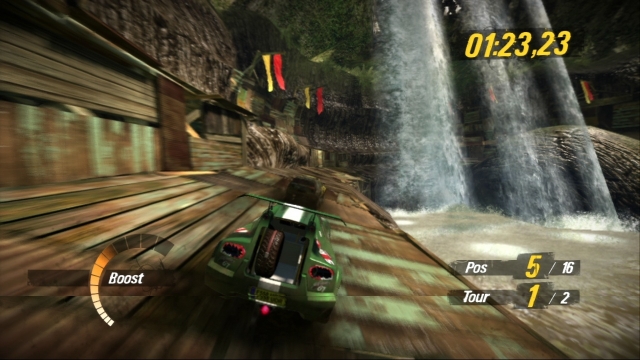
Value for money was MotorStorm’s main weak point and it’s the area that has seen the most work for Pacific Rift. The track count has doubled from 8 to 16, and the music track count has roughly doubled from ~20 to 46. Pacific Rift also includes all of the vehicle types and vehicle skins from the original (and a lot of new ones to boot), while at the same time tracks are on the whole much larger and include even more alternative routes and hidden paths. Perhaps most importantly the game is now full of extras and modes omitted from the first MotorStorm.
As already detailed, the main mode is the Festival mode, which acts like a single player career mode. It consists of 3 different types of races. First of all, there are standard races against AI controlled vehicles. Secondly, the Eliminator mode that came as part of the DLC for MotorStorm has been taken and incorporated into the Festival mode. Eliminator races differ from normal races in that a timer ticks down and every time it reaches zero the person in last place explodes and is eliminated from the race. The third and final type of event is the Speed race. Here there is a timer ticking down and the goal is to race through a number of checkpoints scattered around the track in order to add precious seconds to the clock. These different types of races add more variety to the basic Festival mode, and in the case of the Speed races help you to learn parts of the track you might not otherwise know about or have much experience with. Pacific Rift’s Festival mode is much longer than the original’s; I’ve put about 14 hours into it so far and there are still a few races I’ve yet to earn a podium place in due to the difficulty of those last few races.
The other single player modes are Time Attack and Free Race. Time Attack allows you to select the vehicle and track of your choice, and lets you either race around the track on your own so that you can explore the maps and work out the best routes, or alternatively you can make use of the developer ghosts or download leaderboard ghosts to race against. It’s a surprisingly useful mode and I relied on it a lot to help me learn the best routes to use in the latter stages of the Festival mode. Free Race is exactly as it sounds; it allows you to setup a single race to your own specifications, so you can select the track, amount of laps, your vehicle, the AI difficulty, and the number and types of AI vehicles. The original MotorStorm was heavily criticised for failing to include a single race option, so it’s great to finally see one included here.
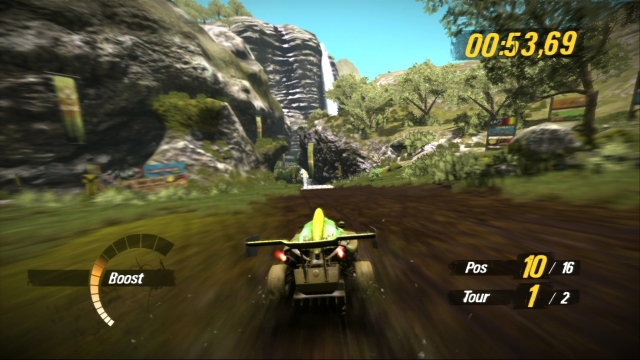
The other main omission from MotorStorm that led to a lot of criticism was the lack of split screen multiplayer. Again, not only has this been included in Pacific Rift, but it’s also brilliantly executed. The game supports up to four player split screen multiplayer without any loss of graphical fidelity. Online multiplayer is also supported, and is largely the same as before. The main difference is that for ranked matches the map is auto-selected by the computer and then users in the lobby can vote to skip it (it’s similar to the system employed in the Call of Duty series), the only downside being that after the race is over you don’t go back to the lobby as a group, so you can’t organise a rematch against public players. I haven’t experienced any lag thus far and it feels very much the same as the original MotorStorm online (but with some noticeable improvements in connectivity). It would be nice to see more online multiplayer options, but what is there works well and it’s certainly an enjoyable experience.
Finally, it’s briefly worth mentioning some of the other extras. As you progress through the Festival mode you unlock concept art and clips (as well as all the other track and vehicle unlockables). There is of course trophy support. There’s also a Photo Mode, where you can pause at any point during the race and take a picture for your PS3 photo gallery (although there are no replays, which would have been nice considering the superb crash sequences you experience in the game). Pacific Rift also tracks all of your statistics, which is always a nice touch for racing games of this type.
MotorStorm: Pacific Rift is a genuinely worthy sequel. Having listened to the criticism that was levelled at the first game, the developers have worked hard to deliver a sequel that improves on almost every aspect of the first game, with particular attention being paid to the amount of content on offer. The result is a game that remains true to the original, although perhaps too much so in the case of the computer AI and some of the other gameplay elements, but which sees solid graphical and technical improvement over the original and includes at least double the amount of content. If you didn’t like the gameplay in the original MotorStorm then steer clear; the difficulty level has been ramped up and the gameplay will only infuriate you even more. If, however, you liked the first game but needed it to include more content to justify your purchase, then Pacific Rift succeeds as a sequel in almost every respect.










|
|
slipknotfan
posted 26/06/2011, 07:52
Instead I'm playing Motorstorm 3,000 times a day!!!! Message | Report |
|
|
Pho_Hybrid
posted 17/12/2010, 03:40
yay but this article says otherwise, in a good way :P http://www.gamesindustry.biz/articles/motorstorm-pacific-rift-passes-one-million-sales Message | Report |
|
|
|
|
|
|
|
|
gipsy_jack
posted 06/12/2010, 07:03
congratulations! very good racing game. I like it. I'm waiting for the next motorstorm apocalypse now Message | Report |
|
|
drakesfortune
posted 05/12/2010, 04:18
One Mil! I can't believe it took this long. This is my favorite racing game this gen. People really should check it out. Message | Report |